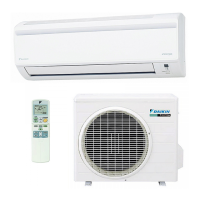Do you have a question about the Daikin FTQ18TBVJUA and is the answer not in the manual?
Only trained personnel should service; equipment not for unsupervised persons with reduced capacities.
Install unit out of public access, do not bypass safety devices, supervise children.
Explains the meaning of DANGER, WARNING, CAUTION, and NOTE symbols.
Hazards include refrigerant gas, improper grounding, flammable materials, and leaks.
Follow manufacturer instructions and local codes for installation and servicing.
Ensure separate power circuits and qualified personnel for electrical work.
Use specified parts, secure covers, ensure strong foundations, and account for weather.
Avoid touching switches with wet fingers and keep children away from the unit.
Wait 5 minutes after operation before removing power; avoid charging cylinders.
Avoid flammable gases, corrosive vapors, and electromagnetic waves for installation.
Keep R-410A clean, dry, and tight; charge as liquid; prevent animal access to outdoor units.
Use specific tools for R-410A; avoid mixing refrigerants; unit not for general public.
Specifies acceptable outdoor and indoor temperature ranges for operation.
Select well-ventilated locations and avoid areas with oil, salt, gas, or voltage fluctuations.
Details functions of Operation Mode, Fan Speed, Menu/OK, Up, Down, Left, Right, On/Off buttons.
Describes the LCD screen and the green operation lamp status.
Apply power to outdoor units at least six hours before starting operation.
Instructions for selecting Cool, Heat, Fan, or Auto modes.
Diagrams illustrating part names for vertical and horizontal unit configurations.
Details on adjusting setpoint, fan speed, and air flow direction.
Explains Defrost Operation and Hot Start features for heating.
Instructions for operating the unit in Dry Mode for dehumidification.
Dry mode dehumidifies space at reduced cooling capacity for comfort.
Adjust temperature, use curtains, and ensure ventilation for efficient operation.
Highlights safety warnings for qualified service personnel performing maintenance.
Recommends cleaning drain pans and consulting dealers for indoor coil cleaning.
Instructions for removing, cleaning (vacuum/wash), and replacing air filters.
Steps for drying the unit, shutting off power, and cleaning before long-term storage.
Recommends replacing the electric heater every 10 years for safety.
Symptoms not indicating heat pump malfunction, like delayed restart or central control.
Addresses system not starting immediately and fan speed differences.
Explains white mist, noise types, dust emission, odors, and remote display messages.
Guides on handling safety device actuation, switch issues, and water leaks.
Troubleshoots power failures, blown fuses/breakers, and blocked inlets/outlets.
Addresses insufficient cooling/heating due to blockages, filter clogs, or improper settings.
Recommends bi-annual checkups and never operating without a filter.
Notes on lubricated motors and safe cleaning practices for aluminum evaporator coils.
Steps to check before calling a servicer: controller, power, fuses, obstructions, filters.
Encourages users to provide product comments via a feedback form or QR code.
Explains the benefits of product registration for additional warranty protection.
Only trained personnel should service; equipment not for unsupervised persons with reduced capacities.
Install unit out of public access, do not bypass safety devices, supervise children.
Explains the meaning of DANGER, WARNING, CAUTION, and NOTE symbols.
Hazards include refrigerant gas, improper grounding, flammable materials, and leaks.
Follow manufacturer instructions and local codes for installation and servicing.
Ensure separate power circuits and qualified personnel for electrical work.
Use specified parts, secure covers, ensure strong foundations, and account for weather.
Avoid touching switches with wet fingers and keep children away from the unit.
Wait 5 minutes after operation before removing power; avoid charging cylinders.
Avoid flammable gases, corrosive vapors, and electromagnetic waves for installation.
Keep R-410A clean, dry, and tight; charge as liquid; prevent animal access to outdoor units.
Use specific tools for R-410A; avoid mixing refrigerants; unit not for general public.
Specifies acceptable outdoor and indoor temperature ranges for operation.
Select well-ventilated locations and avoid areas with oil, salt, gas, or voltage fluctuations.
Details functions of Operation Mode, Fan Speed, Menu/OK, Up, Down, Left, Right, On/Off buttons.
Describes the LCD screen and the green operation lamp status.
Apply power to outdoor units at least six hours before starting operation.
Instructions for selecting Cool, Heat, Fan, or Auto modes.
Diagrams illustrating part names for vertical and horizontal unit configurations.
Details on adjusting setpoint, fan speed, and air flow direction.
Explains Defrost Operation and Hot Start features for heating.
Instructions for operating the unit in Dry Mode for dehumidification.
Dry mode dehumidifies space at reduced cooling capacity for comfort.
Adjust temperature, use curtains, and ensure ventilation for efficient operation.
Highlights safety warnings for qualified service personnel performing maintenance.
Recommends cleaning drain pans and consulting dealers for indoor coil cleaning.
Instructions for removing, cleaning (vacuum/wash), and replacing air filters.
Steps for drying the unit, shutting off power, and cleaning before long-term storage.
Recommends replacing the electric heater every 10 years for safety.
Symptoms not indicating heat pump malfunction, like delayed restart or central control.
Addresses system not starting immediately and fan speed differences.
Explains white mist, noise types, dust emission, odors, and remote display messages.
Guides on handling safety device actuation, switch issues, and water leaks.
Troubleshoots power failures, blown fuses/breakers, and blocked inlets/outlets.
Addresses insufficient cooling/heating due to blockages, filter clogs, or improper settings.
Recommends bi-annual checkups and never operating without a filter.
Notes on lubricated motors and safe cleaning practices for aluminum evaporator coils.
Steps to check before calling a servicer: controller, power, fuses, obstructions, filters.
Encourages users to provide product comments via a feedback form or QR code.
Explains the benefits of product registration for additional warranty protection.












